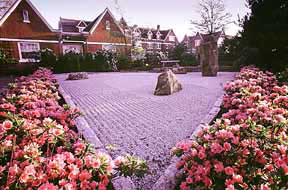


~ The Nityananda Institute | ~ Nepal
| ~ The Kathmandu Valley | ~
Shaivism/Tantra
About Nityananda Institute
 Nityananda Institute
is a community of people dedicated to authentic spiritual practice. Founded
by Swami Chetanananda in 1971,
it is currently based in Portland, Oregon. Nityananda Institute is named
for Bhagavan Nityananda of Ganeshpuri,
India, one of the greatest Hindu saints of the 20th century. Nityananda
Institute seeks to provide students with an opportunity to live a truly
spiritual life, arising from the direct experience of the energy of life
itself.
Nityananda Institute
is a community of people dedicated to authentic spiritual practice. Founded
by Swami Chetanananda in 1971,
it is currently based in Portland, Oregon. Nityananda Institute is named
for Bhagavan Nityananda of Ganeshpuri,
India, one of the greatest Hindu saints of the 20th century. Nityananda
Institute seeks to provide students with an opportunity to live a truly
spiritual life, arising from the direct experience of the energy of life
itself.
In Portland, Nityananda Institute offers instruction and ongoing classes
in meditation, hatha yoga, and Tibetan
Buddhist rituals of the Longchen Nyingthig tradition, intensive practice
retreats with Swami Chetanananda, study groups for spiritual texts, programs
in sacred art, music, and alternative health, and a residential program
at the Rudrananda Ashram.
Nityananda Institute’s first ashram was established in Bloomington,
Indiana, over 30 years ago. The community has always lived and practiced
in an urban environment and been engaged in the life of the surrounding
community. In addition to the Portland headquarters, Nityananda Institute
has centers in Boston, Massachusetts, New York City, Santa Monica, California,
Oslo, Norway, and Kathmandu, Nepal.
The spiritual practice at Nityananda Institute is Trika Yoga, from the
tradition of Kashmir Shaivism. The goal of Trika Yoga is to unify the
three aspects of our being—body, mind and spirit—achieving
a state of dynamic equilibrium among them. Trika Yoga is a non-dualistic
tradition, and its basic philosophical assertion is that all of existence
is nothing but the boundless energy of consciousness.
About Nepal
 Nepal is a visually stunning, geographically diverse, and culturally complex
country situated between India and the region of China known as Tibet.
The kingdom covers approximately 54,000 square miles and as of July, 2003,
had an estimated population of 26,500,000. For its physical size, Nepal’s
biodiversity is unrivalled, ranging from subtropical rainforests to alpine
deserts. Eight out of ten of the world’s tallest mountain peaks lie within
its boundaries.
Nepal is a visually stunning, geographically diverse, and culturally complex
country situated between India and the region of China known as Tibet.
The kingdom covers approximately 54,000 square miles and as of July, 2003,
had an estimated population of 26,500,000. For its physical size, Nepal’s
biodiversity is unrivalled, ranging from subtropical rainforests to alpine
deserts. Eight out of ten of the world’s tallest mountain peaks lie within
its boundaries.
Nepalese society is also marked by ethnic, religious, linguistic and cultural
diversity. Nepal is among the poorest and least developed countries in
the world, with 42% of its population living below the poverty line, yet
it has maintained one of the world’s oldest and richest continuous cultures.
The country’s cultural heritage, particularly contributions made by the
Newars of the Kathmandu Valley to sculpture, painting, and architecture,
is a source of great pride. The Kathmandu Valley is the only place in
the world with 7 UNESCO World Heritage Sites within an 8 mile radius.
There are several factors that contributed to this unique heritage. First,
until after the Second World War, Nepal was inaccessible to westerners.
Only a few diplomats and royal personages were granted access. There were
no roads, so that visitors had to walk or ride from the Indian border.
The routes were difficult and often dangerous.
Second, Nepal has never been subjected to foreign domination. Except for
a brief incursion by Moghul troops from India in the fourteenth century,
there has never been an invasion as such. With over 40 different ethnic
groups speaking 36 languages, the country was a loose grouping of separate
kingdoms for most of its history, and was not even unified as a nation
until the late eighteenth century.
Finally, despite its relative inaccessibility, the Kathmandu Valley has
historically been a renowned center of trade. It is situated on the trade
route between the Gangetic plain of India and the Himalayan range and
has been open to a varied array of cultural influences. Its location along
these trans-Himalayan trade routes made for a prosperous society and an
original culture.
Nepal is remarkable for its religious tolerance. Although it was officially
declared a Hindu state in the early 1990’s, religious life is actually
a blend of Hinduism and Buddhism, overlaid on a substratum of animistic
beliefs. “The two religions and their various schools have existed next
to each other for ages, and being tolerant and non-exclusive, have competed
with one another not by mutual suppression or destruction, but by mutual
accommodation and assimilation.”
(Lydia Aran, The Art of Nepal)
Nepal’s history dates from Neolithic times, and stone tools dating from
as much as 30,000 years ago have been found in the ancient lakebed that
forms the Kathmandu Valley. Many of the ancient holy sites and deities
of the Valley may have originated with these early inhabitants.
History shows that the Khas, an Indo-Aryan people arrived from the West
in about 1000 BCE, and somewhat earlier the Tibeto-Burman people known
as the Kirat had arrived from the east. By 300 AD a dynasty of the Licchavi
family, part of the waves of immigrants from the south, established itself
in Kathmandu. The Licchavi dynasty declined mysteriously after about 900
AD.
In about the year 1200, the Mallas first came to power in the Kathmandu
Valley, and their rule continued uninterrupted for over five hundred years.
By the sixteenth century there were dozens of kingdoms in the smaller
valleys and hills throughout the Himalayan region. It was the destiny
of Gorkha, one of these small kingdoms, to conquer its neighbors and finally
unite the entire nation in the late eighteenth century.
About The Kathmandu Valley
 “Traditionally speaking, the Kathmandu Valley was Nepal, and to
this day it is called Nepal by hill dwellers living as little as a day’s
walk distant.”—Kerry Moran, The Kathmandu Valley
“Traditionally speaking, the Kathmandu Valley was Nepal, and to
this day it is called Nepal by hill dwellers living as little as a day’s
walk distant.”—Kerry Moran, The Kathmandu Valley
Covering only 220 of the total 56,000 square miles that constitute Nepal,
the Kathmandu Valley is home to over 1,500,000 people÷about five percent
of the country’s total population. It is also the location for the
three most historically important cities of Nepal: Kathmandu, Patan and
Bhaktapur.
In early times what is now called Nepal consisted generally of some 20
or more separate kingdoms, and of these the Malla kingdoms in the valley
of Kathmandu, dominated by the Newar tribe, were the most populous. For
centuries, they were Nepal’s political, economic and cultural center,
and the setting for most of Nepal’s history. The Valley’s
fertile soil supported thriving village farming communities, and its location
along trans-Himalayan trade routes allowed merchants and rulers alike
to profit.
The Kathmandu Valley is not only commercially and agriculturally productive,
but a place where spirituality has flourished. The valley’s great
natural power has been enhanced by centuries of devotional worship and
spiritual practice. “At the major power places of the valley, geomantic
significance combines with divine myth and human legend to create a powerful
magnetic vibration.” (Keith Dowman, Power Places of Kathmandu)
Over thousands of years a widespread geographic network of shrines and
sacred places has developed, and the Kathmandu Valley is sometimes called
the Nepal Mandala. The three largest of these shrines—Pashupati,
Swayambhu, and Boudha—remain among the most important and remarkable
temples in the Himalayas, with historical roots going back well before
the birth of the Buddha. The Valley has over 2700 shrines and temples
and has been a major destination for pilgrims from India, the Himalayas
and Tibet. Among its pilgrims are Shiva sadhus, Siddhartha Gautama Buddha,
who, according to legend, taught in the hillside forest that surrounds
Swayambhu, and Padmasambhava, who stopped in Kathmandu on his way to Tibet.
Another major figure is the mahasiddha Goraknath, who spent twelve years
in meditation there.
The original inhabitants of the Valley were animists, a tradition which
survives in the multitudes of spirits, local deities, demons and stones
which are worshipped today. The early Hindu tradition arrived with the
Aryan groups from the West, who introduced the worship of Shiva.
The rise of Buddhism in India in the 5th through 3rd centuries BCE had
a lasting impact on Nepal. Buddhism swept Nepal in succeeding centuries,
and though the Licchavi Kings were Hindu, they paid respect to their predominantly
Buddhist subjects. Both Hindu and Buddhist traditions adapted from the
pre-existing animist practices and from each other. In the medieval period
both religions' practice incorporated mystical, tantric traditions.
The continuing pressures of immigrants from the south, who were mostly
high caste Hindus and firmly wedded to the caste system, and of a Hindu
autocracy brought the more orthodox forms of worship of Shiva and Vishnu
to the fore. By the time the Malla dynasty ascended in the12th century,
Nepalese Buddhism had begun to decline. Except in the north of the country,
where Sherpas and other northerners maintained their Buddhist tradition,
Nepal became a more overtly Hindu country.
Shaivism/Tantra
 The word “tantra” emerged in South Asia in the very earliest
period of writing, which is about the second century AD. The term refers
to various methods by which spiritual practitioners can attain two things:
The first is the release from the cycle of suffering that permeates all
existence. This cycle arises from fundamental misunderstandings about
the nature of ultimate reality. The accomplishment of this goal is called
liberation, or moksha in Sanskrit. The second goal of tantra
is the acquisition of spiritual power, to be used for the benefit of other
human beings. Any use of this power for selfish and means is understood
to bring about the ruin of the person attempting to acquire it.
The word “tantra” emerged in South Asia in the very earliest
period of writing, which is about the second century AD. The term refers
to various methods by which spiritual practitioners can attain two things:
The first is the release from the cycle of suffering that permeates all
existence. This cycle arises from fundamental misunderstandings about
the nature of ultimate reality. The accomplishment of this goal is called
liberation, or moksha in Sanskrit. The second goal of tantra
is the acquisition of spiritual power, to be used for the benefit of other
human beings. Any use of this power for selfish and means is understood
to bring about the ruin of the person attempting to acquire it.
Unlike many traditions which have erected taboos and ritual prohibitions,
the tantric traditions recognize that no area of life is to be rejected.
The experience of freedom, spontaneity, creativity and well-being in this
lifetime are what a tantric practitioner is intent upon gaining.
Unfortunately, in today’s common language, the term "tantra”
may refer to any kind of alternative sexual practices in which people
might engage. This profound misunderstanding is lamentable. Tantra is
not about sex. It is about vital energy, which is the source of all experience,
from the subtlest experience of yourself to the most distant experience
of space. Tantra speaks to the total integration of the subjective and
the objective. Tantra says “I" and it” are one, unified in
consciousness.
Nepal came under the influence of tantrism beginning around 500 AD. By
the Malla period, tantrism had penetrated both Hinduism and Buddhism in
Nepal. “Propelled by the artistic and philosophical genius of the
Newars—a race that first settled the Valley over three thousand
years ago—a Tantric Hindu tradition evolved in Kathmandu that included
aspects of both orthodox Hindu schools, such as Samkya yoga, and the highly
complex metaphysical world of Vajrayana Buddhism.” (Jon Ortner,
Where Every Breath Is a Prayer.)
There are two predominant traditions within Hindu tantrism, Shaiva and
Shakta, derived from the names of two aspects of consciousness—Shiva
and Shakti. Shiva refers to the pure awareness of consciousness while
Shakti refers to the vital creative impulse of consciousness. At the same
time, Shiva and Shakti are recognized as ultimately one and the same.
Shiva is one of the oldest human experiences and expressions of God, often
being depicted as the Lord of Creation and Destruction, the fundamental
rhythm of all life. Shakti is often depicted as Shiva’s consort,
suggesting that pure consciousness and creative energy are inseparable
and ultimately one and the same.
The Himalayas are considered by Buddhist and Hindus alike to be the abode
of Shiva, so it is not surprising that Shiva is the dominant Hindu deity
of the Kathmandu Valley. The earliest religious activity in Nepal appears
to have involved the Pashupata cult, and the worship of a local deity
known as Pashupati, Lord of Beasts, who later became identified as Shiva.
Throughout Nepal’s history, Shiva incarnated as Pashupati has been
venerated as the protector and patron deity of the country. To this day,
Pashupatinath is the principal Hindu temple and cremation ground in the
Valley and one of the most sacred sites in Asia.

![]()
![]()